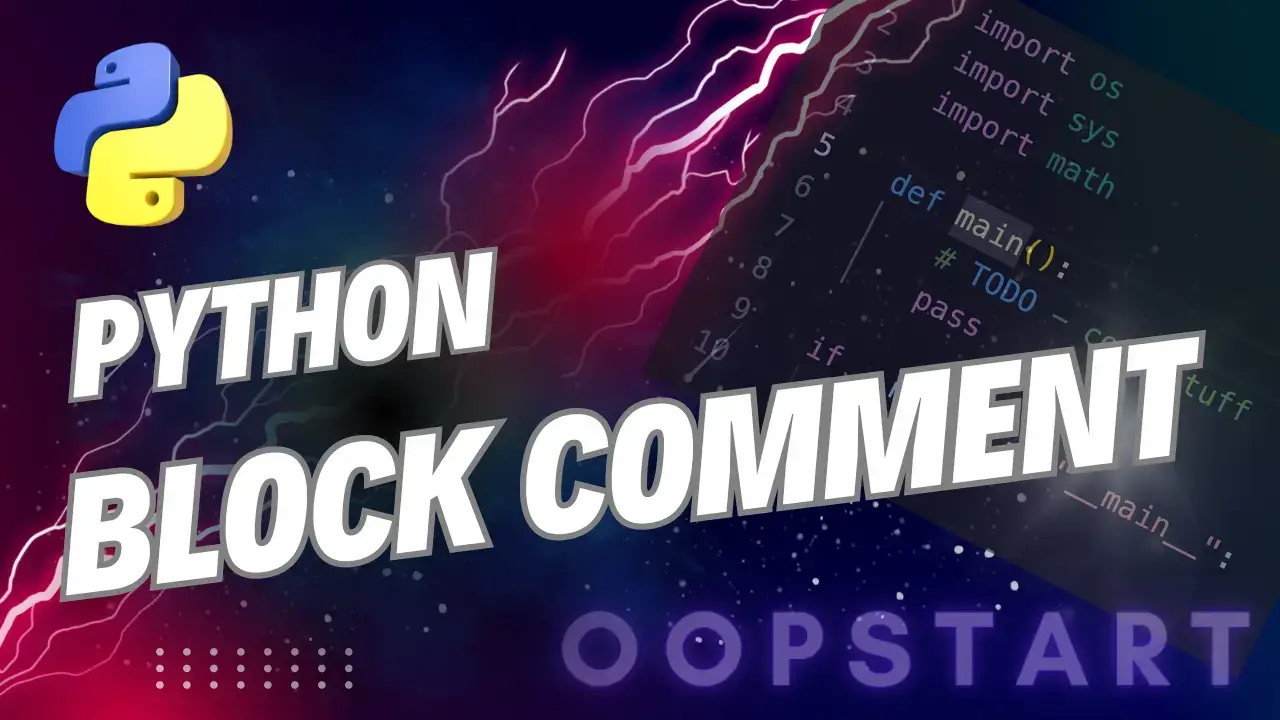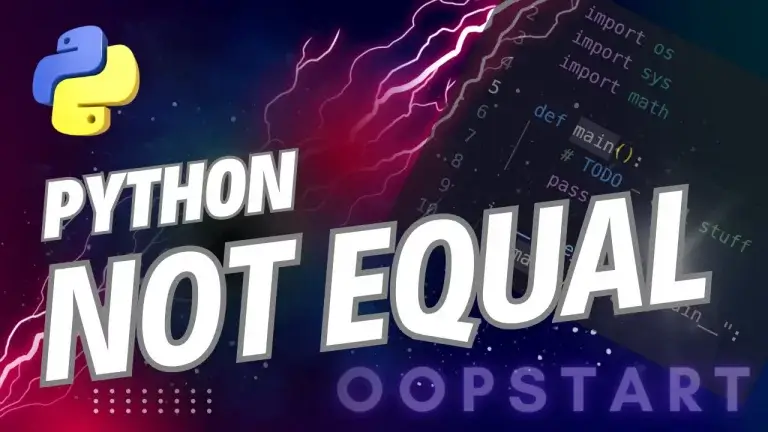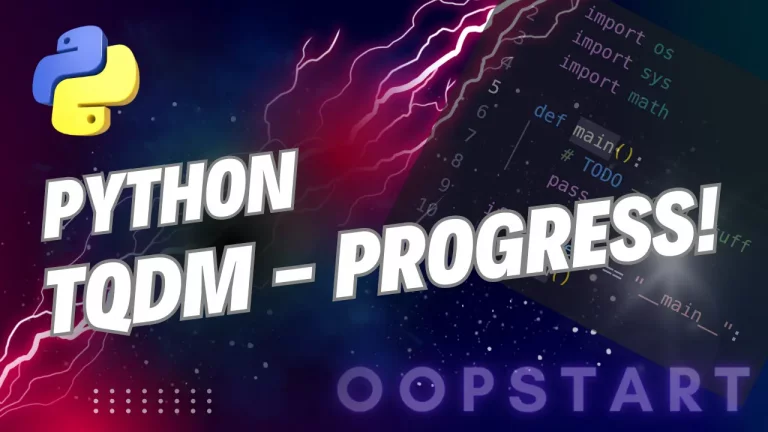Python Block Comment: Deep Dive
In Python, comments are essential to help developers explain code, enhance readability, and make debugging easier.
While Python does not have a formal syntax for block comments like some other programming languages (such as /* */ in C or Java), there are several ways to achieve block comment functionality using Python’s single-line comment syntax or multi-line string literals.
In this guide, you’ll find out how to use a Python block comment effectively and optimize your code for readability and maintainability.
Table of Contents
What Are Comments in Python?
A comment in Python is a line of text in your code that is ignored by the Python interpreter. Comments are primarily used to explain the code or leave notes for yourself and other developers. Comments can also be helpful for disabling lines of code during development or debugging.
Python uses the # symbol to mark a comment. Everything following the # symbol on that line is treated as a comment and will not be executed.
Example of a Single-Line Comment:
# This is a single-line comment in Python
print("Hello, World!") # This prints a message
In the example above, the two comments starting with # are ignored by the interpreter.
What Is a Python Block Comment?
A block comment is a comment that spans multiple lines. Although Python does not have a dedicated block comment syntax like /* */ in languages such as C or Java, there are several ways to write block comments using:
- Multiple single-line comments (
#). - Multi-line string literals (
''' '''or""" """), though this method should be used carefully.
Block comments are helpful when you need to explain a section of code, provide detailed documentation, or disable multiple lines during testing.
How to Write a Python Block Comment
1. Using Multiple Single-Line Comments (#)
The most straightforward way to create a block comment in Python is by using multiple single-line comments, each beginning with a #. This method is the preferred and most Pythonic way of writing block comments.
Example of a Block Comment Using Multiple #:
# This is a block comment in Python.
# Each line starts with the `#` symbol.
# This comment explains the logic behind the function below.
def add(a, b):
return a + b
Pros:
- Clarity: This method makes it clear that all lines are comments.
- Pythonic: This is the recommended approach in Python.
- Widely used: It works across all Python versions and is commonly accepted by most developers.
2. Using Multi-Line String Literals (''' ''' or """ """)
Another way to create a block comment in Python is to use a multi-line string literal. In Python, you can use triple quotes (''' ''' or """ """) to create a string that spans multiple lines. Although these multi-line string literals are primarily used for string values, when not assigned to a variable, Python ignores them. This can simulate a block comment.
Example of a Block Comment Using Multi-Line String Literals:
'''
This is a block comment using a multi-line string literal.
It spans multiple lines and is ignored by the Python interpreter.
'''
def multiply(a, b):
return a * b
Pros:
- Easy to write: Requires fewer characters than using
#for each line. - Useful for disabling code: You can use multi-line strings to temporarily “comment out” a block of code.
Cons:
- Ambiguity: Multi-line string literals can be confused with actual string values in your code, especially if used improperly.
- Not recommended for commenting: Although Python ignores unassigned string literals, they are not intended for commenting. This method is less Pythonic and may be frowned upon in professional settings.
Important Note:
Multi-line string literals should generally be avoided for block comments unless you are documenting code (such as in a docstring) or temporarily disabling a section of code during debugging.
Best Practices for Writing Python Block Comments
1. Use Single-Line Comments for Block Comments
When writing block comments, the preferred method is to use multiple single-line comments with # on each line. This ensures clarity and aligns with Python’s best practices.
Example:
# This block comment explains the purpose of the following function.
# It calculates the factorial of a given number recursively.
def factorial(n):
if n == 1:
return 1
else:
return n * factorial(n - 1)
2. Keep Comments Concise and Relevant
Comments should be clear and to the point. They should explain why the code is written a certain way rather than restating what the code does. Avoid over-commenting, as it can clutter the code and make it harder to read.
Example of Good Comments:
# Check if the number is even or odd
if number % 2 == 0:
print("Even")
else:
print("Odd")
3. Use Multi-Line String Literals for Documentation (Docstrings)
Multi-line string literals should be reserved for docstrings, which are used to document functions, classes, and modules. Docstrings describe the purpose of the code and are displayed by Python’s help system (e.g., using the help() function).
Example of a Function Docstring:
def greet(name):
"""
This function greets the person whose name is passed as an argument.
Args:
name (str): The name of the person to greet.
Returns:
str: A greeting message.
"""
return f"Hello, {name}!"
Common Mistakes When Writing Block Comments in Python
1. Using Multi-Line String Literals Improperly
While using multi-line string literals (''' ''' or """ """) can simulate block comments, it’s generally considered bad practice unless used for docstrings or temporary code disabling. Overusing multi-line string literals for commenting can make your code confusing, as they can be mistaken for actual string values.
Example of Incorrect Usage:
'''
This is a block comment, but it's not recommended.
It could be mistaken for a string value, and it's less readable.
'''
2. Over-Commenting
While comments are important, over-commenting your code can make it less readable. Focus on explaining the why behind your code, not the what. Code should be self-explanatory through variable names, function names, and clear logic.
3. Not Updating Comments
When you modify your code, ensure that the comments are also updated to reflect the changes. Outdated comments can confuse developers and lead to errors.
Advantages of Block Comments in Python
1. Enhances Code Readability
Block comments help explain complex sections of code, making it easier for others (and yourself) to understand what the code is doing, especially after some time has passed.
2. Useful for Debugging
During development, you can use block comments to temporarily disable a chunk of code. This helps in testing and debugging without needing to delete or rewrite the code later.
3. Collaboration
Block comments make it easier for teams of developers to collaborate by explaining code logic, key decisions, and functionality, ensuring that all team members are on the same page.
Disabling Multiple Lines of Code with Block Comments
During debugging or testing, you may want to disable multiple lines of code temporarily. You can do this by turning each line into a comment using multiple # symbols or wrapping the code in a multi-line string literal.
Example: Using # to Disable Code
# def calculate_sum(a, b):
# return a + b
# Temporarily disabled function above
Example: Using Multi-Line String Literal to Disable Code
'''
def calculate_sum(a, b):
return a + b
'''
Note: This should only be done for temporary purposes, as using multi-line string literals this way is not recommended for permanent comments.
Summary of Key Concepts
- Python does not have a dedicated block comment syntax, but you can achieve block comments using multiple single-line comments (
#) or multi-line string literals (''' '''or""" """). - The preferred and most Pythonic way of writing block comments is by using multiple single-line comments.
- Multi-line string literals can be used as temporary block comments for disabling code but should be avoided for long-term commenting.
- Best practices include keeping comments concise, relevant, and updating them as the code changes.
Exercises
- Write Block Comments: Write a Python function that calculates the square of a number. Add block comments using multiple single-line comments to explain the function’s logic.
- Use Docstrings: Write a Python function that takes two numbers and returns their product. Add a docstring that explains the purpose of the function and its arguments.
- Disable Code: Temporarily disable a section of code in your script using both
#symbols and multi-line string literals. Experiment with both approaches to see which is more readable.
Check out our FREE Learn Python Programming Masterclass to hone your skills or learn from scratch.
The course covers everything from first principles to Graphical User Interfaces and Machine Learning
Here is the official Python documentation on comments.
FAQ
Q1: Can I use /* */ for block comments in Python like in other languages?
A1: No, Python does not support the /* */ block comment syntax used in languages like C, C++, and Java. Instead, you must use multiple single-line comments (#) or multi-line string literals (''' ''' or """ """). Using multiple # symbols is the most Pythonic way to achieve block comments.
Q2: What’s the difference between using multiple # comments and using multi-line string literals for block comments?
A2: Using multiple # comments is the preferred and more Pythonic way to write block comments. It is clear and readable and won’t be confused with string literals.
Multi-line string literals (''' ''' or """ """) can also be used to simulate block comments, but this approach can be confusing as these literals are generally meant for string values or docstrings. Multi-line string literals should be avoided for long-term comments unless used for documentation purposes (like docstrings).
Q3: Can multi-line string literals impact performance if not assigned to a variable?
A3: No, if a multi-line string literal is not assigned to a variable or used in code (such as a docstring), Python will ignore it, and it won’t affect performance. However, it’s still best practice to use # for comments, as multi-line string literals can be misleading if someone assumes it’s part of the logic rather than a comment.
Q4: Can I nest block comments in Python?
A4: No, Python does not support nested block comments. Since Python doesn’t have a formal block comment syntax like /* */, you cannot nest comments inside each other. If you attempt to nest multiple single-line comments or multi-line string literals, the inner comment may still be treated as code or text, leading to potential errors or confusion.
Example:
# This is a block comment
# Nested comments are not supported in Python
# You need to use separate comments
Q5: Is there a shortcut to comment/uncomment multiple lines of code at once?
A5: Yes, many IDEs and text editors, like VSCode, PyCharm, or Sublime Text, provide shortcuts for commenting or uncommenting multiple lines of code at once. For example, in most editors, you can:
- Select the lines you want to comment/uncomment.
- Press
Ctrl + /(Windows/Linux) orCmd + /(Mac) to toggle comments on those lines.
This shortcut will automatically add or remove # symbols at the beginning of each selected line.
Q6: When should I use multi-line string literals versus single-line comments (#)?
A6: Use single-line comments with # when writing block comments that explain code sections or logic. This method is cleaner and aligns with Python’s best practices.
Use multi-line string literals only for:
- Docstrings: Documenting functions, classes, or modules.
- Temporarily disabling code: For debugging or testing purposes, though this should not be permanent.
Example (docstring):
def example_function():
"""
This is a docstring, used to describe the function.
It can span multiple lines.
"""
pass
Q7: How do I comment out a large block of code temporarily in Python?
A7: To comment out a large block of code temporarily, you can either:
- Add
#to each line of the code, using an IDE shortcut to comment/uncomment multiple lines quickly. - Wrap the code in a multi-line string literal (
''' '''or""" """), though this method should only be used temporarily.
Example:
# Using multiple single-line comments
# def temporary_function():
# print("This function is commented out.")
# Using multi-line string literal (temporary solution)
'''
def temporary_function():
print("This function is commented out.")
'''
Q8: Can I include comments inside a multi-line string literal?
A8: Technically, you can include comments inside a multi-line string literal, but it is not recommended because multi-line string literals are treated as strings, not comments. Using # inside a string will not be recognized as a comment and could cause confusion.
Example (not recommended):
'''
# This is inside a multi-line string literal
This is not an actual comment and is treated as a string.
'''
It’s better to use # comments outside of the string literal for clarity.
Q9: Are docstrings and block comments the same thing?
A9: No, docstrings and block comments serve different purposes.
- Docstrings: Used to document functions, classes, or modules, and can be accessed programmatically (e.g., using the
help()function). Docstrings are written using multi-line string literals (''' '''or""" """). - Block comments: Explain the logic of a section of code and are written using multiple
#comments. Block comments are not meant to be accessed programmatically.
Example of a Docstring:
def my_function():
"""
This is a docstring used to describe the purpose of this function.
It is displayed when using help(my_function).
"""
pass
Q10: Can I add comments within Python lists, dictionaries, or other data structures?
A10: Yes, you can add comments inside complex data structures like lists and dictionaries, but the comments must be placed on separate lines from the data structure. You cannot place a comment inside the same line as a list element or dictionary key-value pair.
Example:
my_list = [
1, # First element
2, # Second element
3 # Third element
]
my_dict = {
"name": "Alice", # User's name
"age": 30, # User's age
"location": "USA" # User's location
}








